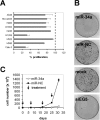Development of a lung cancer therapeutic based on the tumor suppressor microRNA-34
- PMID: 20570894
- PMCID: PMC2913706
- DOI: 10.1158/0008-5472.CAN-10-0655
Development of a lung cancer therapeutic based on the tumor suppressor microRNA-34
Abstract
Tumor suppressor microRNAs (miRNA) provide a new opportunity to treat cancer. This approach, "miRNA replacement therapy," is based on the concept that the reintroduction of miRNAs depleted in cancer cells reactivates cellular pathways that drive a therapeutic response. Here, we describe the development of a therapeutic formulation using chemically synthesized miR-34a and a lipid-based delivery vehicle that blocks tumor growth in mouse models of non-small-cell lung cancer. This formulation is effective when administered locally or systemically. The antioncogenic effects are accompanied by an accumulation of miR-34a in the tumor tissue and downregulation of direct miR-34a targets. Intravenous delivery of formulated miR-34a does not induce an elevation of cytokines or liver and kidney enzymes in serum, suggesting that the formulation is well tolerated and does not induce an immune response. The data provide proof of concept for the systemic delivery of a synthetic tumor suppressor mimic, obviating obstacles associated with viral-based miRNA delivery and facilitating a rapid route for miRNA replacement therapy into the clinic.
(c)2010 AACR.
Figures





Similar articles
-
Developing an effective therapeutic by delivery of synthetic microRNA-520e in lung cancer treatment.Biomed Pharmacother. 2015 Feb;69:249-54. doi: 10.1016/j.biopha.2014.12.009. Epub 2014 Dec 12. Biomed Pharmacother. 2015. PMID: 25661366
-
Antitumor effect of miR-197 targeting in p53 wild-type lung cancer.Cell Death Differ. 2014 May;21(5):774-82. doi: 10.1038/cdd.2014.6. Epub 2014 Jan 31. Cell Death Differ. 2014. PMID: 24488097 Free PMC article.
-
Systemic delivery of synthetic microRNA-451 is an effective therapeutic strategy for the treatment of lung cancer.Int J Mol Med. 2015 May;35(5):1369-73. doi: 10.3892/ijmm.2015.2147. Epub 2015 Mar 18. Int J Mol Med. 2015. Retraction in: Int J Mol Med. 2016 Oct;38(4):1312. doi: 10.3892/ijmm.2016.2693. PMID: 25812923 Retracted.
-
The microRNA miR-34a inhibits non-small cell lung cancer (NSCLC) growth and the CD44hi stem-like NSCLC cells.PLoS One. 2014 Mar 4;9(3):e90022. doi: 10.1371/journal.pone.0090022. eCollection 2014. PLoS One. 2014. PMID: 24595209 Free PMC article.
-
Alternative mechanisms of miR-34a regulation in cancer.Cell Death Dis. 2017 Oct 12;8(10):e3100. doi: 10.1038/cddis.2017.495. Cell Death Dis. 2017. PMID: 29022903 Free PMC article. Review.
Cited by
-
TP53-independent function of miR-34a via HDAC1 and p21(CIP1/WAF1.).Mol Ther. 2013 Sep;21(9):1678-86. doi: 10.1038/mt.2013.148. Epub 2013 Jun 18. Mol Ther. 2013. PMID: 23836017 Free PMC article.
-
miRNA-Based Technologies in Cancer Therapy.J Pers Med. 2023 Nov 9;13(11):1586. doi: 10.3390/jpm13111586. J Pers Med. 2023. PMID: 38003902 Free PMC article. Review.
-
MicroRNAs in insulin resistance and obesity.Exp Diabetes Res. 2012;2012:484696. doi: 10.1155/2012/484696. Epub 2012 Jul 18. Exp Diabetes Res. 2012. PMID: 22851965 Free PMC article. Review.
-
Epigenetic deregulation of microRNAs in rhabdomyosarcoma and neuroblastoma and translational perspectives.Int J Mol Sci. 2012 Dec 5;13(12):16554-79. doi: 10.3390/ijms131216554. Int J Mol Sci. 2012. PMID: 23443118 Free PMC article. Review.
-
High dose glargine alters the expression profiles of microRNAs in pancreatic cancer cells.World J Gastroenterol. 2012 Jun 7;18(21):2630-9. doi: 10.3748/wjg.v18.i21.2630. World J Gastroenterol. 2012. PMID: 22690071 Free PMC article.
References
-
- Bartel DP. MicroRNAs: genomics, biogenesis, mechanism, and function. Cell. 2004;116:281–97. - PubMed
-
- Esquela-Kerscher A, Slack FJ. Oncomirs - microRNAs with a role in cancer. Nat Rev Cancer. 2006;6:259–69. - PubMed
-
- Calin GA, Croce CM. MicroRNA signatures in human cancers. Nat Rev Cancer. 2006;6:857–66. - PubMed
-
- Petrocca F, Lieberman J. Micromanipulating cancer: microRNA-based therapeutics? RNA Biol. 2009;6:335–40. - PubMed
-
- Tong AW, Nemunaitis J. Modulation of miRNA activity in human cancer: a new paradigm for cancer gene therapy? Cancer Gene Ther. 2008;15:341–55. - PubMed
Publication types
MeSH terms
Substances
Grants and funding
LinkOut - more resources
Full Text Sources
Other Literature Sources
Medical
Research Materials
Miscellaneous

